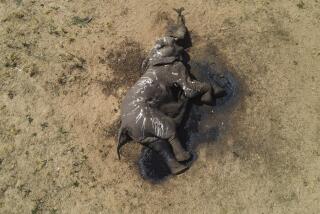Brazen Killing of Rhinos Reignites Fears of Poaching
- Share via
NAIROBI, Kenya — The recent slaughter of four black rhinos at a national park in southeastern Kenya has reignited fears that a new round of poaching could further threaten one of the world’s most endangered mammals.
The killing of the rhinos, which included a mother and her calf, was the first such attack on the animals in eight years in one of Kenya’s protected national parks.
“This is worrying,” said Esmond Bradley Martin, a wildlife expert in Nairobi, the capital, who has written extensively on the lucrative trade in rhinoceros horns. “We are only hoping that we don’t see much more of this [killing].”
The rhinos that were hacked to death late last month at Tsavo East National Park were stripped of their horns and left to rot, according to Connie Maina, a spokeswoman for the Kenya Wildlife Service. A 13-month-old calf, among the youngest of the 51 black rhinos at Tsavo, was one of the dead.
The brazen attack at Tsavo came despite many precautions. Heavily armed rangers are instructed to shoot poachers on sight.
“It is an eye-opener for us,” Maina said. “It is the beginning of poaching again. We have declared a state of high alert.”
Authorities have arrested two suspects in Kenya’s port city of Mombasa and seized several rhino horns, which have been shipped to a laboratory in the United States so that DNA testing can establish their origin.
The black rhino population in Kenya has suffered a catastrophic decline, from 20,000 in 1970 to about 350 in 1987. During that period, poachers slaughtered the animals to send their horns mainly to Yemen, where they were carved into decorative dagger handles. Smaller numbers of horns went to Southeast Asia, where they were ground into a powder used as a fever-reducing medicine.
Poaching has wiped out 80% of Africa’s black rhino population in the last two decades, experts say. The estimated 2,900 black rhinos left on the continent are in Kenya, Tanzania, Namibia, Zambia, Zimbabwe and South Africa.
Kenya has increased its population of black rhinos to about 420 by concentrating the animals in small, highly protected areas, especially on private land. But a number live in national parks.
Martin, who makes frequent trips across Africa and Asia monitoring the illegal trade in ivory and rhino horns, said recent world events might be encouraging rhino poaching.
Supplies of rhino horns, which fetched $590 a pound at the market in Sana, the Yemeni capital, have been exhausted, creating a demand for new stocks, he said.
And President Bush’s decision to freeze the assets of Al Barakaat, Somalia’s largest remittance firm, because of its alleged ties to Osama bin Laden’s terrorist network might also be a factor, Martin said. Many traders who transport rhino horns across the Red Sea to Yemen are Somalis, he said. (Authorities confirmed that one of the suspects arrested in Mombasa is a Somali trader.)
Faced with the need to earn hard currency, Somali traders could be encouraging poachers to take even greater risks by venturing into national parks, Martin said.
A spokesman for the World Wildlife Fund, which supports several projects aimed at increasing the black rhino population, said the organization fears that “renewed poaching, if not halted, is likely to reverse the hard-won gains made in rebuilding Kenya’s black rhino population.”
More to Read
Sign up for Essential California
The most important California stories and recommendations in your inbox every morning.
You may occasionally receive promotional content from the Los Angeles Times.













